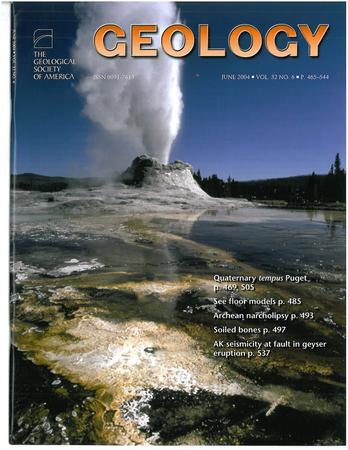古血栓体碳酸盐δ13C值中保存的光合碳循环信号
IF 4.6
1区 地球科学
Q1 GEOLOGY
引用次数: 0
摘要
现今形成的凝块沉积物保存了碳酸盐碳同位素(δ13Ccarb)值,这表明光合作用改变了当地溶解无机碳库的δ13C值,导致碳酸盐矿物的δ13Ccarb值比与周围湖水平衡沉淀的碳酸盐矿物的δ13Ccarb值高1‰~ 6‰。为了验证这些信号是否被保存在地质记录中,我们分析了白垩纪至始新世羊口组(美国内华达州)的血栓形成物的δ13Ccarb值。我们对凝块成分(解释为反映光合作用影响的降水)和相邻的碳酸盐基质(解释为反映非生物降水)进行了织物特异性分析,发现凝块成分的δ13Ccarb值始终被抵消到比相邻基质更高的值。血块与基质之间的平均偏移量(Δ13C)为+2.77‰(±0.94,2 s.e)。这些Δ13C值与光合作用驱动的日碳循环模型的预测一致。模拟的Δ13C值也与有血栓形成的现代湖泊中记录的Δ13C值相匹配。我们认为Sheep Pass组Δ13C值保留了与溶解无机碳库的本地和外部影响相关的信号。织物信息采样可以解开这两个信号,除了确定光合作用的生物特征外,还可以从微生物岩档案中获得更可靠的化学地层学。本文章由计算机程序翻译,如有差异,请以英文原文为准。
Photosynthetic carbon cycling signal preserved in carbonate δ13C values of ancient thrombolites
Thrombolites—clotted organo-sedimentary deposits—forming today preserve carbonate carbon isotope (δ13Ccarb) values that suggest that photosynthesis shifts the δ13C value of the local dissolved inorganic carbon pool, resulting in carbonate minerals with δ13Ccarb values 1‰−6‰ higher than that expected for carbonate minerals precipitated in equilibrium with ambient lake water. To test whether these signals are preserved in the geologic record, we analyzed the δ13Ccarb values of thrombolites from the Cretaceous to Eocene Sheep Pass Formation (Nevada, USA). We performed fabric-specific analyses of both the clot component (interpreted to reflect photosynthetically influenced precipitation) and adjacent matrix carbonate (interpreted to reflect abiotic precipitation) and find that the δ13Ccarb values of clot components are consistently offset to higher values than adjacent matrix. The mean offset (Δ13C) between the clots and matrix was +2.77‰ (±0.94, 2 s.e.). These Δ13C values are consistent with predictions by a model of diurnal carbon cycling driven by photosynthesis. Modeled Δ13C values also match the documented Δ13C values in modern lakes with thrombolites. We interpret that Sheep Pass Formation Δ13C values preserve signals related to both local and external influences on the dissolved inorganic carbon pool. Fabric-informed sampling can disentangle these two signals, allowing for more robust chemostratigraphy from microbialite archives in addition to identification of a biosignature of photosynthesis.
求助全文
通过发布文献求助,成功后即可免费获取论文全文。
去求助
来源期刊

Geology
地学-地质学
CiteScore
10.00
自引率
3.40%
发文量
228
审稿时长
6.2 months
期刊介绍:
Published since 1973, Geology features rapid publication of about 23 refereed short (four-page) papers each month. Articles cover all earth-science disciplines and include new investigations and provocative topics. Professional geologists and university-level students in the earth sciences use this widely read journal to keep up with scientific research trends. The online forum section facilitates author-reader dialog. Includes color and occasional large-format illustrations on oversized loose inserts.
 求助内容:
求助内容: 应助结果提醒方式:
应助结果提醒方式:


